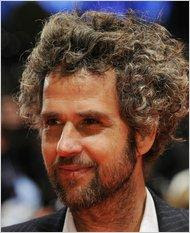
His death was announced by Oliver Golloch, a spokesman for the Ruhr Triennale festival, where Mr. Schlingensief had been working on the premiere of his play “S.M.A.S.H.: Suffocating in Aid,” before his declining health forced its cancellation in July. No details on the cause of death were provided, but Mr. Schlingensief had been ill with lung cancer for several years.
Mr. Schlingensief (pronounced SHLIN-gun-zeef), who once described his artistic program as “total irritation,” waged a tireless assault on received opinion in the arts and politics for more than two decades. He cast repentant neo-Nazis in a Zurich production of “Hamlet” and managed to combine political fable and splatter film in “The German Chainsaw Massacre” (1990), a mad vision of German reunification.
Chancellor Helmut Kohl, the leader of the conservative Christian Democratic Union, was a favorite target. In 1998 Mr. Schlingensief invited all of Germany’s unemployed to swim in the Wolfgangsee lake in Austria, where Mr. Kohl was headed for a holiday. In theory, their combined body weight would cause the lake to flood the resort region of Salzkammergut.
During a performance at the 1997 Documenta art exhibition in Kassel, he nailed up a poster calling for Mr. Kohl’s assassination, a provocation that led to his arrest. In 1998 he formed a political party, Chance 2000, which urged Germans to vote for themselves in the 2000 national elections.
“Schlingensief was a hugely influential artist in Germany,” Tara Forrest, an editor of “Christoph Schlingensief: Art Without Borders,” recently published by the University of Chicago Press, wrote in an e-mail message. His work, she said, “encouraged the audience to think critically and creatively about issues like immigration, unemployment, homelessness, the rights of disabled people and the Nazi legacy in contemporary Germany.”
Christoph Maria Schlingensief was born on Oct. 24, 1960, in Oberhausen, in the industrial Ruhr valley. His father was a pharmacist and his mother a pediatric nurse. As a child he made short films with a hand-held camera, but he twice failed to gain admission to the Munich School of Film and Television. For a time he studied German language and literature, philosophy and art history, but dropped out of school to work as an assistant to the experimental filmmaker Werner Nekes.
After making several low-budget independent films, he came to public attention with his “Germany Trilogy” (1989-92), a raucous, absurdist depiction of modern German history, replete with sex and violence, that included “100 Years of Adolf Hitler: The Last Hours in the Fuhrer’s Bunker,” “The German Chainsaw Massacre” and “Terror 2000 — Intensive Care Unit Germany.”
Reviewing “Terror 2000” for The New York Times, Stephen Holden wrote: “If a Keystone Kops film were written by William S. Burroughs, peopled with characters from George Grosz by way of Russ Meyer and directed in a style that suggests Jean-Luc Godard on speed, you would have a movie with the style and mood of ‘Terror 2000.’ ”
In 1993 Mr. Schlingensief was invited to mount a stage version of “Terror 2000” at the Volksbühne Theater in Berlin. The result, “100 Years of the Christian Democratic Union: A Game With No Limits,” was a multimedia satire on contemporary Germany that included massacres, simulated orgasms, excrement, vomit and an appearance by the author as a kind of ringmaster in the final act. One German critic summed up the production as “resolutely juvenile and unspeakably German.”
Delighted at the response — the words appear on Mr. Schlingensief’s official Web site (schlingensief.com) — Mr. Schlingensief went on to direct several other plays at the theater, including “Kühnen 94, Bring Me the Head of Adolf Hitler,” its title referring to the neo-Nazi leader Michael Kühnen.
In the late 1990s, Mr. Schlingensief reached a broader audience as the director and unpredictable host of the television interview show “Talk 2000,” a high-risk proposition for guests, since Mr. Schlingensief would occasionally turn on them, start talking about his personal problems or simply nod off as the cameras rolled.
In “U3000,” a wilder talk-show venture, he moved frantically from car to car on the Berlin metro with camera crew in tow. “Freakstars 3000,” his answer to shows like “American Idol,” invited Germans with disabilities to display their talents.
His production of Wagner’s “Parsifal” at the 2004 Bayreuth Festival, despite a dead hare onstage, failed to administer the expected shock treatment. “Schlingensief was here, but Bayreuth is still standing,” a critic for the weekly Die Zeit wrote.
Far more contentious were his political street performances, notably “Please Love Austria,” a stunt inspired by the reality television series “Big Brother.” Shortly after a far-right, anti-immigration party joined Austria’s governing coalition in 2000, Mr. Schlingensief arranged for a dozen asylum seekers to live for a week in a shipping container placed next to the Vienna Opera House. As part of the provocation, Austrians were asked to vote two of them out of the country each day.
Much of his later work, like the play “Atta Atta: Art Has Broken Out,” an inquiry into art’s possibilities in a violent world, and the art and theater project “Church of Fear,” dealt with the global political climate after the terrorist attacks of Sept. 11, 2001.
After learning he had lung cancer (he was not a smoker), Mr. Schlingensief wrote about his illness and in 2009 published “Heaven Could Not Be as Beautiful as Here: A Cancer Diary.”
He also began writing his memoirs, which were scheduled to be published next month, and threw his declining energies into creating an opera village in Burkina Faso that was to include an opera house, a theater and film school, and an infirmary.
He is survived by his longtime assistant, the costume designer Aino Laberenz, whom he married last August.
[Source]
Christoph Schlingensief, Artistic Provocateur, Dies at 49
Saturday, 28 August 2010
Subscribe to:
Post Comments (Atom)





0 komentar:
Post a Comment
Insert Ur Comment!